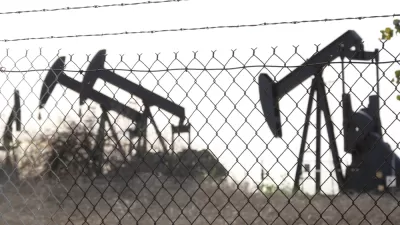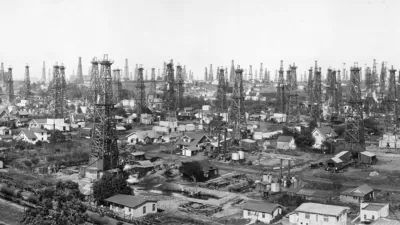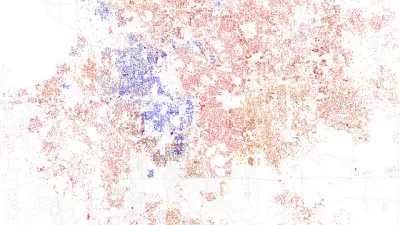Research shows neighborhoods historically redlined by the federal government have twice as many oil and gas extraction projects as “desirable” neighborhoods.

A first-of-its-kind analysis from a research team from the University of California, Berkeley, the University of California, San Francisco, and Columbia University highlights the correlation between historical redlining and oil and gas wells in neighborhoods. As Julia Kane writes, “[The research team] compared data on the location of plugged and active oil and gas wells to data from maps generated by the Home Owners Loan Corporation, the federal lending program created to prevent home foreclosures during the Great Depression.”
Looking at data for 33 cities where oil and gas wells are drilled and operated in urban neighborhoods across 13 states, researchers discovered the striking correlation between neighborhoods that were redlined and neighborhoods that have a high density of oil and gas wells.
While the study did not establish a causal link between redlining and drilling, Kane notes, “It’s not news that redlined communities tend to experience worse health outcomes. There are also links between neighborhoods that have undergone disinvestment and neighborhoods where there are higher rates of gun violence and less green space.”
This can directly affect the health of communities living near extraction sites. “Numerous studies have found that living near oil and gas wells increases a person’s risk of cardiovascular disease, impaired lung function, anxiety, depression, preterm birth, and impaired fetal growth — serious concerns for the estimated 17 million people in the U.S. who live within a mile of at least one active well.”
FULL STORY: Historically redlined neighborhoods have twice the number of oil and gas wells

Alabama: Trump Terminates Settlements for Black Communities Harmed By Raw Sewage
Trump deemed the landmark civil rights agreement “illegal DEI and environmental justice policy.”

Planetizen Federal Action Tracker
A weekly monitor of how Trump’s orders and actions are impacting planners and planning in America.

How Atlanta Built 7,000 Housing Units in 3 Years
The city’s comprehensive, neighborhood-focused housing strategy focuses on identifying properties and land that can be repurposed for housing and encouraging development in underserved neighborhoods.

In Both Crashes and Crime, Public Transportation is Far Safer than Driving
Contrary to popular assumptions, public transportation has far lower crash and crime rates than automobile travel. For safer communities, improve and encourage transit travel.

Report: Zoning Reforms Should Complement Nashville’s Ambitious Transit Plan
Without reform, restrictive zoning codes will limit the impact of the city’s planned transit expansion and could exclude some of the residents who depend on transit the most.

Judge Orders Release of Frozen IRA, IIJA Funding
The decision is a victory for environmental groups who charged that freezing funds for critical infrastructure and disaster response programs caused “real and irreparable harm” to communities.
Urban Design for Planners 1: Software Tools
This six-course series explores essential urban design concepts using open source software and equips planners with the tools they need to participate fully in the urban design process.
Planning for Universal Design
Learn the tools for implementing Universal Design in planning regulations.
Caltrans
Smith Gee Studio
Institute for Housing and Urban Development Studies (IHS)
City of Grandview
Harvard GSD Executive Education
Toledo-Lucas County Plan Commissions
Salt Lake City
NYU Wagner Graduate School of Public Service





























